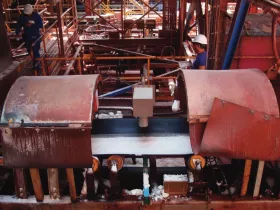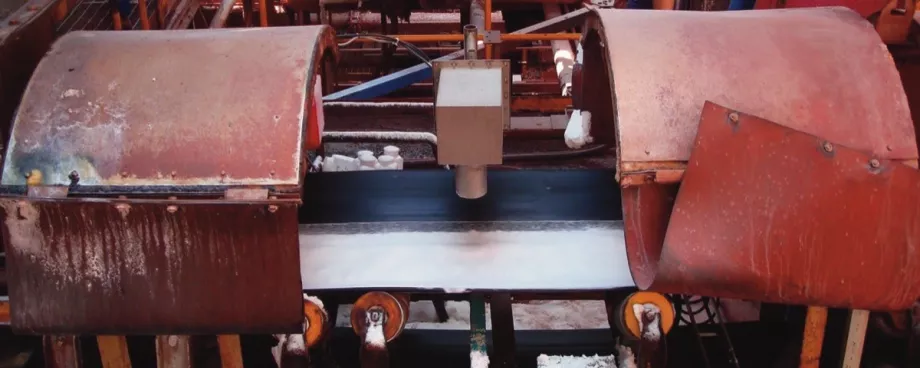
MoistTech Corporation manufactures a NIR (near-infrared) sensor that can not only measure moisture content but also thickness and temperature if needed as well – all in one sensor. Unlike other instrumentation of this type, their IR3000 is insensitive to material variations such as particle size, material height and color, and gaps in product flow, These moisture sensors provide continuous, reliable readings. After their initial calibration, and due to their non-drift optical design the sensors are maintenance free allowing operating personnel to confidently make immediate process adjustments based on real-time measurements. This sensor is ideal for all installation locations including belt, screw and enclosed conveyers, chutes, cyclones and bines, dryer input / output, webs, and pipeline or pneumatic conveying. The sensor(s) can be located throughout the process and directly connected to the users PLC or any laptop; Ethernet 4-20 mA are included as well as our high-tech Windows operating software with the purchase of a sensor.
- Product quality monitoring
- Process optimization
- Fuel consumption savings
- Water savings
- Dust prevention
Moisttech offers the only NIR sensor equipped to measure up to 3 constituents at once, has a one-time calibration and zero maintenance on the unit, providing the user with sustainable equipment to produce outstanding results for his customers.
Examples
Controlling the Moisture Content in Tobacco
Having the correct moisture levels in Tobacco has become a critical component during the various stages of production. Processors are constantly adjusting moisture and heat during the conditioning process to maintain the quality of their product. With the help of industry partners and 30 years of knowledge and experience, Moisttech has developed the 828 tobacco moisture sensor that is ideally suited to measure the moisture levels in leaf processing, expanded, cut and reconstituted tobacco.

The sensor’s ability to measure under the widest variations in process temperature, material height, color and ambient lighting distinguish a few of its features. A major propriety development incorporated in the system is its product loss software capability where small gaps, inert material or foreign objects are removed from the measurement calculation thus providing an accurate and true moisture reading making the sensor ideal also for installations on chain conveyors and screw conveyors. The 828 is designed for the harshest process environments, e.g., dust and steam do not effect on the instruments readings. However, if the sensor must be installed close to the dryer outlet where it will be susceptible to extreme heat conditions, it may be necessary to cool the sensor with either air or water. It is recommended to install the 828 sensors in several locations throughout process beginning with feed forward control, post dryer, cutting, conditioning and prior to primary processing. The sensor should be mounted several inches above the conveyor so that it can continuously monitor the process and can control the moisture content either manually or automatically.
The Importance of Moisture Content in Pelletized Biomass
Two of the most important properties of pellet fuels are their moisture content, and inorganic ash content. The Pellet Fuel Institute (PFI) standards require that for even the lowest commercial grade of pellets, the moisture content cannot exceed 10% and the inorganic ash content cannot exceed 6%. This means that great care must be taken when choosing and drying feedstocks for pelletization.

Testing for moisture and ash can be a time-consuming process. The ASTM standard test methods can take upwards of 4 hours and require an oven, a furnace, and a mass balance to run. Moisture measurement and control is a crucial aspect in the bioenergy application and Moisttech’s new IR3000 moisture sensor allows the user to do instant, non-contact, continuous moisture measurement. Moisttech recommends installing sensors in several locations throughout the pellet process. First, installing a sensor prior to the dryer will monitor the moisture levels going in. Too dry of a product will result in over drying causing a dusty, ambient environment but could also result in a fire. Installing sensors after the dryer, prior to the pelletizer will also result in significant cost savings. Product too dry will prevent pellets compacting and not molding together very well. Product too wet could cause the pelletizer to plug up – both resulting in shutting down the line and product waste.
Moisture in Cement, Sand and Aggregates
The IR3000 operates reliably and where other sensors cannot. Whether you work with fine grain to large aggregates in very dry or saturated conditions, the IR3000 is easy to integrate into process lines, conveyors, bins and/or silos. The IR-3000 takes instant, non-contact measurements of moisture in % dry and % wet measurements, and regulates moisture content either automatically or manually to suit your needs. It’s also capable of measuring temperature and other important constituents.S ensor calibrations, measurement wavelengths, algorithms and sensor optical requirements are pre-set at the factory. Typical accuracy of the IR 3000 as well as of the 828 type sensor is about ±0.1% on low moisture applications and ±0.25% on high moisture applications. Complete measurement ranges are 0-65% moisture. The intelligent pre-processing of the measurement values (300+ per second) allows for smooth average values, adjustable filters, and up to 50 standard calibration curves, stored in the sensor. Three self-powered analog outputs 4-20mA, allow for the easy connection to control system and a very advanced PC software is included at no charge with connections via Ethernet or RS232/485.
A Standard for most Materials
Moisttech has researched moisture and its application in numerous manufacturing processes for over 35 years. We’ve taken our decades of experience and knowledge, along with feedback from our industry partners, to develop our superior moisture sensor range.
■







